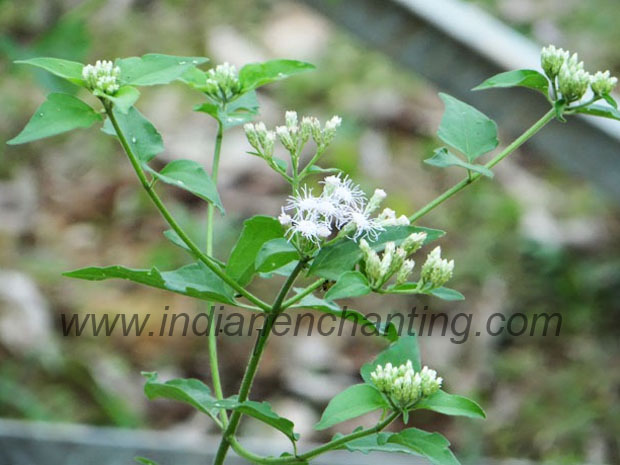
Chromolaena odorata king
Genus: Chromolaena
Botanical name: Chromolaena odorata King
PLANT NAME IN DIFFERENT LANGUAGES
Sanskrit: Ropani, Seekhrasarpi
English: Eupatorium, Eupatorium odoratum, Common floss flower
Hindi: bagh dhoka, tivra gandha
Malayalam: Communist pacha, Venappacha, Assam pacha
MEDICINAL PROPERTIES
Chromolaena odorata, commonly known as Siam weed or chromolaena, is a perennial herbaceous plant belonging to the Asteraceae family. Here are some key characteristics and a brief description:
1. Appearance
– It typically grows as a shrub or small tree, reaching heights of up to 3 meters (10 feet).
– The stems are green to reddish-brown and often have purplish stripes.
– Leaves are opposite, broadly ovate to lanceolate, and coarsely toothed along the edges. They are usually 5-15 cm long.
2. Flowers
– The flowers are small and white, borne in dense clusters at the ends of branches.
– Flowering occurs year-round in tropical regions where it thrives.
3. Habitat
– Chromolaena odorata is native to the Americas but has become invasive in many tropical and subtropical regions worldwide.
– It thrives in disturbed areas, open fields, roadsides, and forest edges.
4. Ecological Impact
– It is considered one of the world’s worst weeds due to its aggressive growth and ability to outcompete native vegetation.
– Chromolaena odorata forms dense thickets, shading out other plants and reducing biodiversity.
5. Uses
– Despite its status as a weed, some cultures use parts of Chromolaena odorata in traditional medicine for treating various ailments.
– It has also been studied for potential pharmacological applications.
6. Control
– Management of Chromolaena odorata often involves mechanical and chemical methods due to its resilience and rapid spread.
– Biological control using natural enemies specific to the plant has also been explored in some regions.
In summary, Chromolaena odorata is a highly adaptable and invasive plant species with significant ecological and economic impacts in many parts of the world. Its ability to spread rapidly and dominate ecosystems makes it a challenging weed to control.
